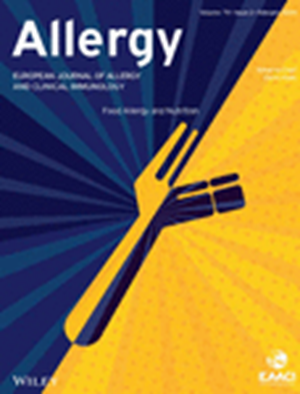非甾体抗炎药加重呼吸系统疾病的组学研究:来自上、下呼吸道的最新证据
IF 12
1区 医学
Q1 ALLERGY
引用次数: 0
摘要
非甾体抗炎药(NSAID)加重呼吸系统疾病(N-ERD)是一种主要的2型炎症性疾病,包括哮喘、鼻息肉和对非甾体抗炎药的超敏反应。其发病机制涉及上下气道,但迄今为止大多数研究分别检查了这两个隔室。考虑到N-ERD的临床表现涉及这两个部位,目前尚不清楚鼻子、鼻窦和肺部的分子机制是不同的还是重叠的。在这篇综述中,我们总结了现有的组学研究——转录组学、蛋白质组学、代谢组学和表观基因组学——在N-ERD患者的上、下气道中进行的研究。虽然组学方法揭示了新的分子见解,但由于设计、控制和方法的异质性,研究间的比较受到限制。我们强调需要整合多组学分析和标准化框架,以更好地表征跨气道疾病。这些努力对于确定强大的生物标志物和治疗靶点以及对N-ERD的系统级理解至关重要。本文章由计算机程序翻译,如有差异,请以英文原文为准。
Omics in NSAID-Exacerbated Respiratory Disease: Current Evidence From the Upper and Lower Airways.
Nonsteroidal anti-inflammatory drugs (NSAID)-exacerbated respiratory disease (N-ERD) is a mainly type 2 inflammatory condition that combines asthma, nasal polyps, and hypersensitivity to NSAIDs. Its pathogenesis involves both upper and lower airways, yet most studies to date have examined these compartments separately. It remains unclear whether the molecular mechanisms in the nose, sinuses, and lungs are distinct or overlapping-an important gap, given that clinical manifestations of N-ERD involve both sites. In this review, we summarize available omics studies-transcriptomics, proteomics, metabolomics, and epigenomics-performed on upper and lower airways in patients with N-ERD. While omics approaches have revealed new molecular insights, comparisons across studies are limited by heterogeneity in design, controls, and methodology. We emphasize the need for integrated multi-omics analyses and standardized frameworks to better characterize the disease across airways. Such efforts are essential for identifying robust biomarkers and therapeutic targets and for moving toward a systems-level understanding of N-ERD.
求助全文
通过发布文献求助,成功后即可免费获取论文全文。
去求助
来源期刊

Allergy
医学-过敏
CiteScore
26.10
自引率
9.70%
发文量
393
审稿时长
2 months
期刊介绍:
Allergy is an international and multidisciplinary journal that aims to advance, impact, and communicate all aspects of the discipline of Allergy/Immunology. It publishes original articles, reviews, position papers, guidelines, editorials, news and commentaries, letters to the editors, and correspondences. The journal accepts articles based on their scientific merit and quality.
Allergy seeks to maintain contact between basic and clinical Allergy/Immunology and encourages contributions from contributors and readers from all countries. In addition to its publication, Allergy also provides abstracting and indexing information. Some of the databases that include Allergy abstracts are Abstracts on Hygiene & Communicable Disease, Academic Search Alumni Edition, AgBiotech News & Information, AGRICOLA Database, Biological Abstracts, PubMed Dietary Supplement Subset, and Global Health, among others.
 求助内容:
求助内容: 应助结果提醒方式:
应助结果提醒方式:


